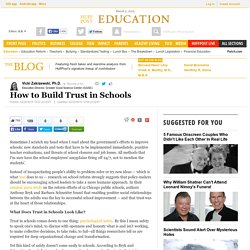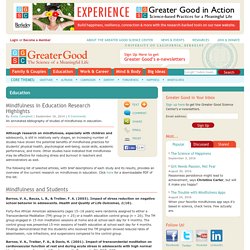

How to Build Trust in Schools Sometimes I scratch my head when I read about the government's efforts to improve schools: new standards and tests that have to be implemented immediately, punitive teacher evaluations, and threats of school closures and job losses.

All methods that I'm sure have the school employees' amygdalae firing off 24/7, not to mention the students'. Instead of incapacitating people's ability to problem-solve or try new ideas -- which is what fear does to us -- research on school reform strongly suggests that policy-makers should be encouraging school leaders to take a more humane approach.
In their seminal 2002 study on the reform efforts of 12 Chicago public schools, authors Anthony Bryk and Barbara Schneider found that enabling positive social relationships between the adults was the key to successful school improvement -- and that trust was at the heart of those relationships. What Does Trust in Schools Look Like? Trust in schools comes down to one thing: psychological safety. Re-imagining school. Education positive : Et si le bonheur était enseigné à l'école ? Qu'est ce qu'un bon prof ? La question des méthodes pédagogiques a toujours soulevé des discours passionnés.

Au Québec comme en France, le débat fait rage autour des réformes de l’enseignement. De plus en plus de travaux soulignent l’impact d’un « effet-prof » sur les performances des élèves. À partir de travaux anglo-saxons, le chercheur québécois Clermont Gauthier propose des clés pour un « enseignement efficace », s’appuyant sur une pédagogie explicite. Au passage, il renvoie dos à dos la pédagogie traditionnelle, centrée sur la transmission de savoirs, et les pédagogies « centrées sur l’élève ».
Existe-t-il des pratiques pédagogiques plus efficaces que d’autres ? Dr Mark Greenberg 'Nurturing Mindfulness in Education' at Mind & Its Potential 2012. Eight Tips for Teaching Mindfulness in High School. When I walked in to teach my first mindfulness class at a charter high school in Oakland, no one seemed interested.

One student was sleeping in his chair; a few kids were messing around in the classroom. Our Mindful Mondays series provides ongoing coverage of the exploding field of mindfulness research.Dan Archer Everyone looked at me like I was in the wrong place. I was nervous and not really sure what I would do. So I just started talking about stress. That was the right move.
Here are eight more lessons I’ve learned. 1. Classes that are smaller than 12 people are very different from class sizes of 12 or more, for the students in smaller groups are much more willing to share. Studies of the relationship between learning and classroom size show that students perceive smaller classes as being able to foster a greater sense of belonging and togetherness, tighter relations with teachers, and more classroom participation. But you can create more intimacy even with a bigger class. 2. 3. 4. 5. Tips for Teaching Mindfulness to Kids. How can we build the quality of mindfulness in our children, our classrooms, and our schools?

The Oakland-based Mindful Schools program, of which I am a co-founder and co-director, teaches children in public and private elementary, middle, and high schools how to be more mindful of their thoughts and actions. As of the fall of 2009, Mindful Schools had brought our five-week in-class mindfulness training to over 7,000 children in 26 schools, 22 of which serve low-income children. The program is secular, extremely cost-effective, and uses short, interactive exercises that are tailored for children. Both quantitative and qualitative responses from teachers, principals, and students have indicated that our program greatly improves the classroom and the overall school environment. Purpose. Susan Kaiser Greenland - Inner Kids. Mindfulness in Education Research Highlights. Although research on mindfulness, especially with children and adolescents, is still in relatively early stages, an increasing number of studies have shown the potential benefits of mindfulness practices for students’ physical health, psychological well-being, social skills, academic performance, and more.

Other studies have indicated that mindfulness may be effective for reducing stress and burnout in teachers and administrators as well. The following list of selected articles, with brief descriptions of each study and its results, provides an overview of the current research on mindfulness in education. Click here for a downloadable PDF of this list.
Sciences à l'école. Teaching. Formation. Numérique. Susy Platiel. Fondamentaux.